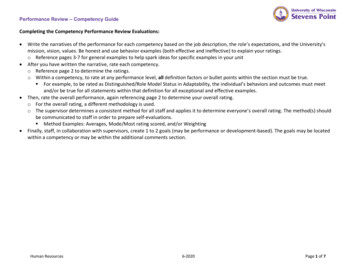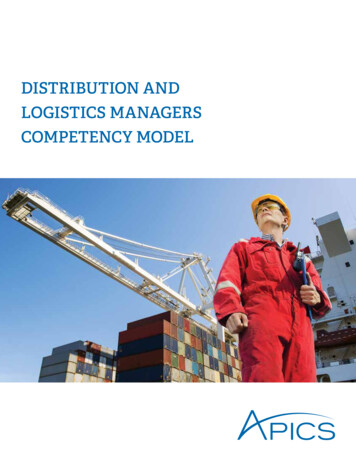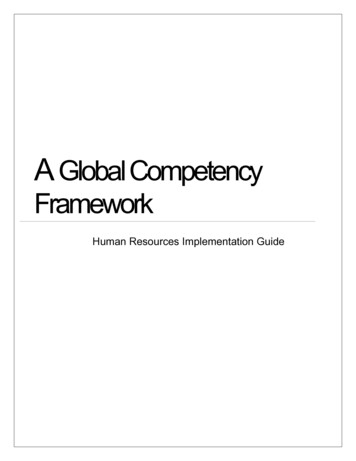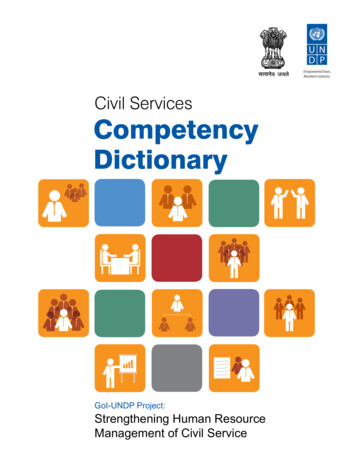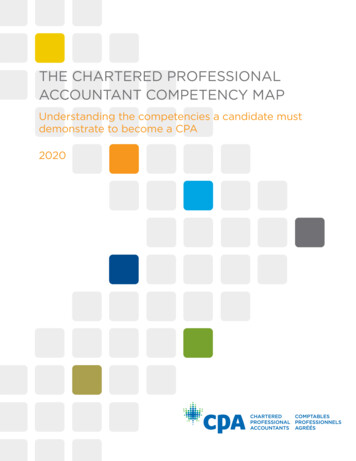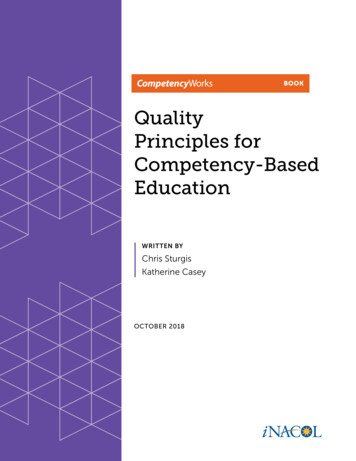
Transcription
BOOKQualityPrinciples forCompetency-BasedEducationWRITTEN BYChris SturgisKatherine CaseyOCTOBER 2018
Quality Principles forCompetency-Based EducationWRITTEN BY:Chris SturgisKatherine CaseyOctober 2018
Quality Principles for Competency-Based EducationThis publication builds off of the early ideas introduced in the paper In Search of Efficacy: Defining the Elements of Qualityin a Competency-Based Education System, developed for the 2017 National Summit on Competency-Based Education.After a series of revisions building on input from experts and practitioners in the field, we have authored this book toadvance quality frameworks for competency-based education. Please see the summary report from the Summit, Qualityand Equity by Design: Charting the Course for the Next Phase in Competency-Based Education, which seeks to advanceK-12 competency education along four key issues: quality, equity, meeting students where they are and policy.We deeply appreciate the input from the summit participants listed in the appendix and the following members of theTechnical Advisory Group on Quality for their insights in developing the ideas presented here: Jan Bermingham, ElaineBerry, Mandi Bozarth, Harvey Chism, Carisa Corrow, C. Wesley Daniel, Theresa Ewald, Pat Fitzsimmons, Amy Fowler,Cynthia Freyberger, Thomas Gaffey, Laurie Gagnon, Jim Goodell, Renee Hill, Sue Lanz, Paul Leather, Kathleen McClaskey,Joy Nolan, Alfonso Paz, Karla Phillips, Alexandra Pritchett, Jeff Renard, Tom Rooney, Bror Saxberg, Andrea Stewart, CirceStumbo, Vincent Thur, Jonathan Vander Els and Glenda Weber.The members of the Technical Advisory Group on Developing a Working Definition of Competency-Based Educationhave also played an invaluable role in shaping a deeper understanding of competency-based education. We thank thefollowing individuals who shared their substantial expertise to build a shared understanding of competency education:Laureen Avery, Ana Betancourt, Michael Burde, Kim Carter, Cris Charbonneau, Rose Colby, Margaret Crespo, Cory Curl,Julia Freeland Fisher, Jenni Gotto, Virgel Hammonds, Christina Jean, Paul Leather, Amalia Lopez, Christy Kingham, MichaelMartin, Adriana Martinez, Rebecca Midles, Rosmery Milczewski, Gretchen Morgan, James Murray, Joy Nolan, JenniferNorford, Karla Phillips, Linda Pittenger, David Richards, Antonia Rudenstine, David Ruff, Sydney Schaef, Don Siviski, MeganSlocum, Brian Stack, Wendy Surr, Cyndy Taymore, Eric Toshalis, Barbara Treacy, Claudette Trujillo and Jonathan Vander Els.We are grateful for the generosity and leadership of our funders. The support and partnership of the Nellie Mae EducationFoundation, Barr Foundation, Carnegie Corporation of New York, the Chan Zuckerberg Initiative and the Donnell-KayFoundation have been invaluable in advancing knowledge in the field of personalized, competency-based education.About CompetencyWorksCompetencyWorks is a collaborative initiative dedicated to advancing personalized, competency-based education in K-12and higher education. iNACOL is the lead organization with project management facilitated by MetisNet. We are deeplygrateful for the leadership and support of our advisory board and the partners who helped to launch CompetencyWorks:American Youth Policy Forum, Jobs for the Future and the National Governors Association. Their vision and creativepartnership have been instrumental in the development of CompetencyWorks. Most of all, we thank the tremendouseducators across the nation who are transforming state policy and district operations, as well as schools that are willing toopen their doors and share their insights.About iNACOLThe mission of iNACOL is to drive the transformation of education systems and accelerate the advancement ofbreakthrough policies and practices to ensure high-quality learning for all.ISBN #978-0-692-17514-9Please refer to this book as Sturgis, C. & Casey, K. (2018). Quality principles for competency-based education. Vienna, VA:iNACOL. Content in this book is licensed under a Creative Commons Attribution 4.0 International license.
CONTENTSI.Introduction. 5II.Understanding Competency-Based Education. 9A. Readiness for College, Career and Life: The Purpose of K-12 Public Education Today . 10B. How Does Competency-Based Education Differ from the Traditional System of Education?. 12C. Competency-Based Education and Personalized Learning Go Hand in Hand .22III. Sixteen Quality Design Principles. 25A. Purpose and Culture Design Principles.30#1 Purpose-Driven . 31#2 Commit to Equity . 37#3 Nurture a Culture of Learning and Inclusivity . 41#4 Foster the Development of a Growth Mindset .45#5 Cultivate Empowering and Distributed Leadership.48B. Teaching and Learning Design Principles. 53#6 Base School Design and Pedagogy on Learning Sciences.54#7 Activate Student Agency and Ownership.59#8 Design for the Development of Rigorous Higher-Level Skills.63#9 Ensure Responsiveness.66C. Structure Design Principles.70#10 Seek Intentionality and Alignment.71#11 Establish Mechanisms to Ensure Consistency and Reliability. 77#12 Maximize Transparency. 81#13 Invest in Educators as Learners. 87#14 Increase Organizational Flexibility.92#15 Develop Processes for Ongoing Continuous Improvement and Organizational Learning.96#16 Advance Upon Demonstrated Mastery.99IV. Conclusion. 105V.Glossary. 107VI. About the Authors.113VII. Endnotes.115
SECTION I.IntroductionPerformance-based learning is right for kids and it’sright for teachers.Heather O’Brien, Teacher and President of Mesa Valley EducationAssociation, District 51, CO, 201615
Q UA L IT Y P RI NCI P LE S F O R CO M P E T E N C Y-B A S E D E D U C AT I O NCompetency-based education—also referred to asso powerful. The competency-based structure will falter ifmastery-based, performance-based and proficiency-it rests on the same beliefs and assumptions upon whichbased—is gaining momentum. In recent years anthe traditional system was built. Moreover, students willincreasing number of districts and schools have adoptednot benefit unless provided with effective instruction andcompetency-based education. Districts and schools turnassessment firmly grounded in the learning sciences. Thus,to competency-based education for different reasons:the Quality Design Principles are organized by culture,to develop globally competitive graduates, to designpedagogy and structure.schools that promote what is best to help students learn,to achieve greater equity, to create a system of continuousA commitment to integrate all of the Quality Designimprovement and learning, and to foster deeper learning.Principles is necessary to create a high-quality, sustainablecompetency-based system. When districts and schoolsStates are creating innovation space for competencyimplement some, but not all, it is unlikely that they will seeeducation by launching pilots, creating innovation zonessustainable improvement or realize success for all students.and introducing proficiency-based diplomas to transformConsider, for example, a school that tries to increasethe education systems.2 As the number of districts andtransparency with standards-based grading but fails to buildschools turning to competency education expands, somethe capacity to cultivate a growth mindset for studentshave done so with a deep foundational understanding ofor to provide greater instructional support to respond tothe purpose, culture and key elements. Others have not,struggling students. This school will be unlikely to seeinstead treating competency education as a technicalhigher engagement or achievement because its structuralreform or resorting to piecemeal implementation. As achange was not supported by an aligned change to cultureresult, some competency-based schools have not servedand pedagogy.students in a way that fulfills the promise of the model, andmany students are not benefitting as much as they could.As states, districts and schools re-design educationFurthermore, insufficient attention to quality due to rapidsystems, the 16 Quality Design Principles provide agrowth and inadequate understanding jeopardizes thecohesive framework that offers a set of guideposts forpotential impact and successful scaling of competency-schools and districts. While all principles are essential,based education.districts and schools are using different entry points tobegin transforming their systems and make differentAs it is frequently noted, “Every system is perfectly designeddesign choices. Furthermore, they will find themselves atto get the results it gets.”3 This report, developed indifferent stages of integrating each of the principles intocollaboration with practitioners as part of the Nationaltheir operations. To be clear, quality does not require aSummit on K-12 Competency-Based Education, offerssingle model or approach. In fact, schools and districts with16 Quality Design Principles to guide the development ofstrong results find themselves engaged in an ongoing cyclecompetency-based schools with the goal of creating aof continuous improvement and innovation. No matter thesystem in which every student succeeds. While producingentry point, the depth of implementation or the model,high-quality schools certainly requires attention to thethe Quality Design Principles are composed to sparkstructure, policy and operations, it also requires replacingdiscussion that will accelerate the shift from the paradigmthe underlying beliefs and culture of the traditional systemof the traditional system to one that seeks to have everywith an inclusive culture of learning. In fact, it is the verystudent succeed by personalizing learning. We hope thatbeliefs, assumptions and values that shape the culture of athe Quality Design Principles will be a doorway to deeperquality competency-based school that make its structureunderstanding and innovation.6iNACO L
I n tro d u ctio nWorking Definition of Competency-Based Education (2011)In 2011, 100 innovators in competency education came together for the first time. At that meeting, participants finetuned a working definition of high-quality competency education:»» Students advance upon demonstrated mastery. By advancing upon demonstrated mastery ratherthan on seat time, students are more engaged and motivated, and educators can direct theirefforts to where students need the most help.»» Competencies include explicit, measurable, transferable learning objectives that empowerstudents. With clear, transparent learning objectives, students have greater ownership over theireducation.»» Assessment is meaningful and a positive learning experience for students. New systems ofassessments give students real-time information on their progress and provide the opportunityto show evidence of higher order skills, whenever they are ready, rather than at set points in timeduring the school year.»» Students receive timely, differentiated support based on their individual learning needs.Students receive the supports and flexibility they need, when they need them, to learn, thrive andmaster the competencies they will need to succeed.»» Learning outcomes emphasize competencies that include application and creation ofknowledge, along with the development of important skills and dispositions. Personalized,competency-based learning models meet each student where they are to build the knowledge,skills and abilities they will need to succeed in postsecondary education, in an ever-changingworkplace and in civic life.“We looked at several different school models, and each one is different. It quickly becameclear to us that we can’t tell people how to do it. We want to support education entrepreneurswho can create a personalized learning school using their vision and strengths.”Aaryn Schmuhl, Assistant Superintendent for Learning and Leadership, Henry County School District, GA, 20164i N ACOL7
SECTION ased learning has pushed ourteachers to think about planning in a new wayas well. We are asking ourselves, ‘How willthey know that students get it? What questionsshould I anticipate from the students?’ Someof our really good teachers are becoming greatteachers through mastery-based learning.Penny Panagiosoulis, Principal, KAPPA International HighSchool, New York City Department of Education, NY, 201659
Q UA L IT Y P RI NCI P LE S F O R CO M P E T E N C Y-B A S E D E D U C AT I O NUnderstanding competency-based education takes time,reflection and the willingness to challenge assumptions.Most of us grew up and were shaped by our experiences inthe traditional school system with its focus on schedules,ringing bells telling us to move to the next class, pointsfor good behavior and summative assessments that toldus what we know but didn’t help us learn what we didn’tknow. With so many sharing the same experience, it isn’teasy to imagine a different system that personalizes theA. Readiness for College,Career and Life: ThePurpose of K-12 PublicEducation Today“The mastery-based approach iseducational experience to the degree that all studentschanging what it means to graduate. Before,are fully engaged and receiving the support they needwe had the language of all students to beto advance. Misconceptions about competency-basededucation develop when only one aspect of the traditionalprepared for college and careers. With aschool is challenged—such as pace or grades. In fact,mastery-based diploma, it becomes morecompetency-based education is a redesign of the cultureoperationalized.I ask students to talk to meand structure of school systems to support effectiveinstruction and learning.clearly and with compelling reasons whycollege isn’t for them. They have to have aIn this section, two different ways to explore competency-meaningful alternative. The one situationbased education are offered for those who are new tothat is unacceptable is for a student to notcompetency-based education, as well as those who areseeking to further deepen their understanding. We beginwant to go to college because they aren’tby revisiting the purpose of the K-12 public educationprepared or because college is too hard.”system to understand how desired outcomes can drivethe education system. Then we provide an analysis ofDavid Prinstein, Principal, Windsor Locks Middle School, WindsorLocks School District, CT, 20166the traditional system followed by a comparison with thedistinguishing features of competency-based education.Effective system design starts with a clarity of purpose, orsaid another way, what are the results we want to get fromour system of public education? The current design of ourK-12 public education system delivers the following results:After decades of policy reforms and targeted improvementstrategies, the on-time graduation rate has inched up to 82percent, with states ranging from 61 percent to 91 percent.Yet, inequitable outcomes remain. Alaska Natives, studentswith disabilities, Native American, African American andLatino students continue to graduate at much lower rates:55, 64, 70, 73 and 76 percent, respectively.710iNACO L
U n d er s ta n d i n g C o m p ete n c y- B a s e d E d u c atio nAmong those students who graduate high school, nearly 25their own paths.12 This vision is available to all students,percent of them, from all socioeconomic groups, requirenot simply those on a particular path or from a limited setremedial courses in college, costing them and their familiesof backgrounds. Competency-based culture, structures 1.5 billion a year. Graduates who enter the world of workand pedagogical strategies are designed to ensure thatdirectly after high school fare no better, with 62 percentall students will attain these outcomes. While college andof employers by one account indicating that “high schoolscareer readiness are absolutely central to any educationalaren’t doing enough to prepare their graduates to meetsystem, the definition used in most states today isthe expectations of the workplace.” Students are not fullymore limited than the vision of educational equity thatprepared for civic engagement to ensure a functioningcompetency-based education makes possible. For thisdemocracy (only 30 percent of today’s young peoplereason, it is important to begin with a statement of thebelieve it is “essential” to live in a country that is governedintended purpose for competency-based education.89democratically.) These results are evidence that students10are not getting what they need, and the implications rippleUnlike traditional systems of K-12 education, competency-through their lives, their families, communities and ourbased structures place an equal emphasis upon academiceconomy. In the next section, we will explore why theknowledge, the skills to transfer and apply that knowledgetraditional system is designed to produce these results.(higher order skills), and a set of lifelong learning skillsFirst, let’s consider what results we want instead.that enable students to be independent learners. Lifelonglearning skills that empower students include growthSo, what is the purpose of public education today, andmindset, metacognition, self-regulation and other socialwhat are the results we want it to deliver? States andand emotional skills, advocacy, and the habits of success.districts define the purpose of education in a variety ofDistricts that are pursuing competency-based systemsdifferent ways. Increasingly that purpose is stated asshare a belief that the current purpose of K-12 education is“college and career readiness,” or a variation thereof. Butto facilitate a process through which all students graduatewhat does it really mean to be college and career ready?high school with the academic and lifelong learning skills toAlthough the terminology and details may vary, almost allbe leaders in their communities, visionaries and agents ofstates and districts continue to use a combination of time-their own success—whether in college, career or navigatingbased academic credits, state graduation exams and statethe opportunities and challenges they will encounter inaccountability exams to measure learning. For the majoritytheir lives. While each community expresses its own valuesof states, these elements prioritize content knowledgeand goals in the choices it makes around curriculum,rather than skills, with a focus upon a narrow set of areas—pedagogy and school rituals, this core purpose is shared bymath and English language arts.districts leading the way in competency-based education.High-quality systems of competency-based educationAs discussed in more detail below, we believe competency-start with a community’s aspirations for students. Thesebased education offers the most effective culture andsystems begin with the recognition that merely completingstructure for achieving this educational purpose. This clear12 years of school is an insufficient outcome for students.articulation and understanding of purpose sets us up nowThough each is different, high-quality competency-to turn to why the traditional system is unable to fulfillbased education systems include goals that students willthis purpose and how competency-based education isbe able to articulate a vision for their futures, exercisedesigned to best achieve it.11agency in pursuing that vision and effectively navigatei N ACOL11
Q UA L IT Y P RI NCI P LE S F O R CO M P E T E N C Y-B A S E D E D U C AT I O NB. How DoesCompetency-BasedEducation Differ fromthe Traditional Systemof Education?“The best thing about mastery-basedlearning is that teachers have confidenceMany schools struggle to produce better outcomeslargely because the traditional system is not set up to doso. Despite educators’ persistent best efforts to supportevery student, the traditional system passes students onbefore they have mastered each stage of learning. Thosewho have mastered the required skills continue on a pathtoward graduation and college. For those who have not,little is offered to help them learn what was expected. Theresult is a new set of students each year who may not havethe necessary prerequisite skills and knowledge to take onthe content offered by each successive year’s teachers. Thissets up teachers and students alike for failure. This sortingthat students are learning. Before we didn’tfunction of traditional education is exacerbated by unequalreally know if students were learning.”and inequitable school resources that continue to hauntCasey Smith, Assistant Principal, KAPPA International High School,New York City Department of Education, NY 201613Before exploring key issues in a competency-based system,the education system.“Graduation is a great day for educators.it is valuable to unpack why the traditional system is anWe are saying to the world, ‘We’ve had themobstacle to creating high-achieving schools and equitablefor 12 or 13 years and we’re sending themoutcomes. The strategies used by districts in response tostate accountability exams including delivering grade-levelout into society. They are our product, ourcurriculum regardless of what students know, exposedcontribution to society.’ The reality for manythe limitations of the traditional system for what it is andof our graduates is that they soon find outhow it reinforces inequitable achievement. At the timethe accountability policies made sense as an effort tothey didn’t get what they needed. Some ofcreate transparency and expose inequitable outcomes, butthe kids fall into deep despair when theythey do not help to serve students equitably, nor do theyrealize they have been betrayed. They werepromote effective learning and teaching according to alltold that they are ready, but they’re not.”we know about the learning sciences.Tom Rooney, Superintendent, Lindsay Unified School District, CA, 20151412iNACO L
U n d er s ta n d i n g C o m p ete n c y- B a s e d E d u c atio nTen Flaws in the Traditional SystemThe traditional system is simply not designed to produce the goals we have set for it, or that our children,communities and nation so desperately need and deserve. There are 10 primary flaws in the traditional system thatperpetuate inequity and low achievement. They can be corrected by redesigning the system for success in which allstudents achieve mastery. These flaws of the traditional system are listed below.Purpose and CultureThe traditional system is focused on a narrow set of academic outcomes emphasizing academic skills, memorizationand comprehension of content. It fails to recognize that student success is dependent on more than academicknowledge. Success requires a full range of foundational skills including social and emotional skills and the ability totransfer knowledge and skills to new contexts. Competency education is designed to help students learn academicknowledge, the skills to apply it and lifelong learning skills that are needed to be fully prepared for college, career andlife.The traditional system is built on a fixed mindset—the notion that people’s “abilities are carved in stone.” Purposeincludes ranking and sorting students creating “winners” and “losers” and perpetuating patterns of inequality in society.In contrast, a competency-based education system is built upon a growth mindset with a belief that all children canlearn with the right mix of challenges and supports.15 Competency-based education meets students where they are toensure that each one can be successful to the same high college- and career-ready standards.The traditional system relies upon a bureaucratic, hierarchical system that perpetuates traditional roles, culturalnorms and power dynamics. These said dynamics value compliance and doesn’t support inclusivity and culturalresponsiveness. Competency education seeks to create an empowering, responsive system that is designed to buildtrust and challenge inequity.PedagogyThe traditional system is organized to efficiently cover the curriculum based on age and depends on extrinsicmotivation. Traditional systems developed before the emerging research about what we know about how children learnand are motivated. In competency-based education, everything should be rooted in what we know is best for studentsin terms of engagement, motivation and learning. Competency education fosters intrinsic motivation by activatingstudent agency and providing multiple pathways for learning to the same high standards.The traditional system targets supports to students when their academic or behavioral needs are identified assignificantly above or below the norm (i.e., special education, gifted). Competency-based education provides timelyand differentiated instruction and support. Schools offer daily flex time and time for students to receive additionalsupport before and after the semester.The traditional system emphasizes assessment for summative purposes to verify what students know. One-size-fits-allassessments are conducted at predetermined points of time or at end of unit and are administered to all students atthe same time and in the same format on the same content. In competency-based schools assessment for learningwith robust formative assessment contribute to student growth. A balanced system of assessment aligns with highexpectations that students learn how to transfer knowledge and skills through performance-based assessment. Whenpossible, assessment is embedded in the personalized learning cycle.i N ACOL13
Q UA L IT Y P RI NCI P LE S F O R CO M P E T E N C Y-B A S E D E D U C AT I O NStructureThe traditional system allows high variability in how educators determine proficiency. Competency-based systemsensure consistency in expectations of what it means to master knowledge and skills. Districts build educator capacity tomake judgments of student mastery to the same high standards.The traditional system articulates opaque learning objectives and performance expectations with limited informationfor students about their learning cycle. Students receive grades with little guidance on what is needed to do better oropportunities for revision. Competency-based education values transparency with clear and explicit expectations of thelearning cycle and architecture including what is to be learned, the level of performance for mastery and how studentsare progressing.The traditional system uses academic grading practices that can often send mixed messages and misleading signalsabout what students know by reflecting a mix of factors, including behavior, assignment completion and getting apassing grade on tests, not student learning. Grading in competency education is designed to communicate studentprogress in learning academic skills and content as well as the skills they need to be lifelong learnersThe traditional system is time-based. Schools batch students by age and move them through the same content andcourses at the same pace. Students advance to the next grade level after a year of schooling regardless of what theyactually learned. Competency-based education is based on learning: students must demonstrate mastery of learning,with schools monitoring pace and of
This publication builds off of the early ideas introduced in the paper In Search of Efficacy: Defining the Elements of Quality in a Competency-Based Education System, developed for the 2017 National Summit on Competency-Based Education. After a series of revisions building on input from experts and practitioners in the field, we have authored this book to





